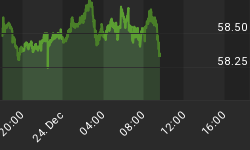Dow Jones Industrial Average 10,641
Value Line Arithmetic Index 1,892
30-Year Treasury Index 4.56%
Gold 1/10 Ounce $45.82
The Big Picture for Stocks
The 4-year cycle is negative into 2006.
Technical Trendicator (1-4 month trend):
Stock Prices Down
Bond Prices Down
Gold Price Up
Bill Fleckenstein in his daily market commentary (https://www.fleckensteincapital.com/home.aspx) on September 15, had this to say about gold:
"Speaking of the currency that can't be printed, gold saw a potentially earth-shaking pronouncement yesterday at a conference in London. Dennis Gartman noted the following quote from Juan Basco, who heads up market operations at the Central Bank of Argentina: 'We don't rule out increasing our gold holdings in the future, which would depend on the economic environment. Gold is recovering its role as an asset protecting the portfolio against inflation and international financial crises.'
According to Dennis: 'Mr. Basco went on to say that the bank had been selling gold rather aggressively from 1997 onward, for it had gotten far-better returns on its assets elsewhere . . . until now. In 1991, he said that gold was 19% of the bank's total reserves. That had dwindled to only 3% in recent months, and that the bank is now in the process of reversing that trend. What was even more stunning was the added statement that other central banks 'in the region' were looking at doing the same thing.'
Wanting to know more, I scanned the Financial Times, where I found the following paraphrase of a comment by Mr. Basco: 'He considers gold a liquid asset, which could be bought and sold easily and help meet any international debt repayments.' In other words, ladies and gentlemen, gold is in fact a currency, and one possessing features superior to the paper variety (even if it's a pain to lug around or try to make change with).
Thus, the thought process whereby central banks decide to become buyers of gold, not sellers of gold, is now under way. Mr. Basco and his friends cannot be the only group of people to have undergone this transformation. Prospectively, I would expect to see more central banks buying gold and fewer selling gold - exactly the recipe for dramatically higher prices over time."
This could be the most important investment concept for the next couple of years. Gold is beginning to return in the thinking of central bankers as an asset that should be bought rather than sold.
There are other reasons why things continue look up for gold. Katrina's cost to the US government may exceed the wars in Afghanistan and Iraq combined. There is no fiscal discipline on the part of any political party, so the costs will be from debt. As Alan Abelson puts it in this weeks Barron's column, "The nation's budget deficit is a cinch to go from merely staggering to positively stupendous."
Consider the supply/demand characteristics of gold. The supply of gold and gold mining stocks is low compared to other assets. For example, the market value of every gold mining company in the world is $200 billion. For comparison, the market cap of General Electric is $300 billion.
Most investors are underweighted in gold. How often do you hear pension funds mention their asset allocation to gold? Never - because they do not own any. This is just one source of potential demand. Demand for gold comes from every corner of the globe. One can expect that speculators will begin to rush to gold in the near term, probably before the central banks and pension fund people get in.
In the meantime, in spite of the recent advance, the price of gold is at record lows relative to oil. And gold is not far from historic lows versus the stock market averages.
Fortunes have been made in gold from time to time. I remember as a young Merrill Lynch broker in the 1970's, we had a customer that would come into our office and buy shares in obscure gold mining companies. This chap was a dapper gentleman who always wore a high-dollar sport coat, a dress hat, and a smile. He would stand at the back of the boardroom and rummage through the constantly humming paper newswire. Occasionally he would walk over to his broker and give him an order to buy a few thou sand shares of some obscure South African gold mining stock selling for pennies a share. This went on for months.
This guy was not my client, so I do not know how much money he made when the gold boom hit. But I am sure it was millions, because all those little gold stocks went up in value by enormous percentages.
There is tremendous leverage in small junior gold mining stocks. When the price of gold goes up, gold reserves that were not economic to mine become, well, a veritable gold mine.
It could happen again. A major change in the perception of gold by investors, traders, and central bankers may be in the cards. Don't be surprised if we see gold having some days with the yellow metal up $10-20 per ounce.
In the meantime, stay with or add to the gold stocks and bullion on our Special Situations list. The average annualized rate of return on all positions closed from this list is in excess of 100%. I think our gold positions, which have lagged our industrial plays, have the potential to exceed this rate of return for a period of time.















